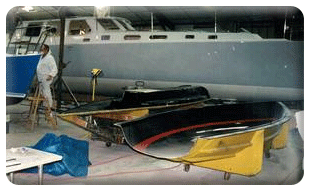|
Page 1 | Page
2 | Page
3 Next
Page >
Listed below is the Wyliecat Factory and the basic building
process used throughout the Wyliecat line. Page one of
three.
 An
empty Wyliecat 17 mold. An
empty Wyliecat 17 mold.
In the foreground is the empty hull mold for the Wyliecat 17. The
red line is a guide for the different colors of gelcoat. Also visible
in this photo are a few other Wyliecat's under construction at the
factory. In the background you can see a nearly-complete Wyliecat
65, SRV “Derek M. Baylis”, and on the left is the bow
of a Wyliecat 30.
|

